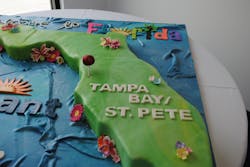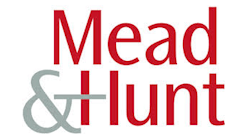Akron-Canton Airport (CAK) has been impacted by airline consolidation over the years along with the larger size of the aircraft airlines are now using.
Lisa Dalpiaz, director of marketing and air service development for CAK, said there are a ton of good routes for airlines to launch out of the market, but they understand the limited resources available to them.
While some routes may look great with a 75-seat aircraft, the airline may only use 170 seat aircraft, making the route less appealing.
“We know it’s not a personal decision, just a business decision,” Dalpiaz said. “It helps us to tailor our message to them.”
Dalpiaz said CAK works to make sure airlines are successful in the market. The airport works at financial responsibility to take on as many costs as possible to keep costs per enplanements low while making sure the facilities accommodate their needs without being expensive.
“We try from the facilities standpoint to keep things so it’s successful for them,” she said. “We also work really tightly with their sales teams to be able to identify where we can be promoting to our corporate partners.”
Building a line of communications
Joseph Pickering, vice president of air service consulting for Mead & Hunt, said airports should have a realistic understanding of their market before contacting airlines, so they can provide effective information to build potential routes.
He said Mead & Hunt worked with a client who had a company in their region that merged with another in the Pacific Northwest, which generated a lot of travel. The spiked demand allowed the airport to make a pitch to an airline for a new destination because the numbers made the business case.
While carriers like Spirit, Frontier and Allegiant have double capacity in recent years, Pickering said legacy carriers like United and American are also adding service to small non-hub cities and driving the growth in the smaller markets.
“Allegiant started out almost exclusively serving non-hub and small hub airports, but they too have gone into the larger airports,” he said. “Don’t rule out those legacy carriers, especially American and United.”
Nicholas Haan, principal, air service development for Crawford, Murphy & Tilly said it’s important for smaller and midsized airports to have a good relationship with the four main airlines in the U.S. in order to get the service you want in your community.
“It’s so competitive with so many airports going after so few resources,” he said.
Haan said the ULCC model is changing, which is evident in Frontier Airlines recent decision to add 15 flights out of Newark Liberty International Airport (EWR).
“A lot of the reason the ULCCs are able to get those low costs is they’ve taken the tact that Frontier has, which is get really big airplanes. Spirit did the same thing getting 320s and 321s and just jam them full of seats,” he said. “When you’ve got that many seats on an airplane, we’re not going to be really looking at small markets like Allegiant has historically. They’re going to be looking for big markets.”
Each airline has its own business model, so Pickering said you need to craft your information to fit the airline.
“A meeting with Sprit may be very different than a meeting you might have with American,” he said. “Someone like Sprit flies less than daily service typically and they’re typically looking at coming in with low fare stimulation and that’s far different than what someone like American is going after, which is that core business traveler.”
Pickering said it’s important to have one point person to work with the airlines to keep the communication going.
“Often times the airport director is too busy and gets pulled into too many other projects,” he said. “It’s really important to have one person on point to work day in and day out with the consultants and the airlines.”
Find your strengths
Bishop International Airport (FNT) is rebuilding its air service after the loss of Southwest Airlines in 2018.
Pat Corfman, director of marketing and public relations for Bishop International Airport, said AirTran had set the tone for FNT being the low fare airport in Michigan, so they made a concerted effort to get Allegiant Airlines to start service to Flint.
American Airlines and United Airlines have both ramped up service in Flint, but being so close to the Delta Air Lines hub in Detroit makes it so there’s only a certain amount of diversity of service that’s going to thrive at FNT, Corfman said.
“Our largest potential for future growth is the low-cost carrier arena,” she said. “You have all of the options of [Detroit Metropolitan Wayne County Airport] to our south. We’re never going to be the airport that has 10 flights per day to Newark.”
Haan suggested airports do a catchment study and reprioritize and focus on what the most important service is.
“I don’t think it’s really effective to go into American Airlines and say we want service to all your hubs and here are the reasons why,” he said. “You need to do a thoughtful analysis of what is the best opportunity for your market and the carrier you’re talking to and solidify that argument.”
CAK is improving its market data as well, Dalpiaz said, to make sure airlines have all the right information to make the right route decisions into the market.
She said it’s also important to keep up good relations with airlines that may have left your market.
“As you know, things change all the time,” she said. “If they go under new leadership and their strategy changes, they could come back.”
Meet the airline needs
Dalpiaz said the facilities team at CAK keeps lines of communication open with airlines to understand their needs and challenges at the airport. This includes making sure they can meet the technology demands of the airlines.
“As technology is advancing and the airlines are doing a wonderful job of adopting it, we’re trying to be more proactive and asking them what they need,” she said. “What kind of technology, what kind of hookups, are there any kinds of upgrades they see coming in the future. We have to be mindful that it fits within our budget, but it’s nice that we are able to plan for it ahead of time so we can see some of these things coming up.”
Dalpiaz said all airports in Ohio are working to secure air service development funds from the state to help with risk mitigation when airlines launch new routes.
“Ohio is surrounded by a bunch of other states that provide state funding and ours doesn’t, which is ironic because we’re the birthplace of aviation,” she said. “All of our airports have been working pretty closely with our Ohio Aviation Association to go to our state legislators and tell them how important this is.”
Corfman said all airlines are looking for a good partner who work with them. As an airport, you want to be supportive of whatever decisions network planners make for your market. When they begin a new flight to start in the market, they want to see the community support it.
“As we court the carriers and we look at certain services we’d like them to fill, we do work with them when they start a new service to the city that’s not existing,” said Nino Sapone, interim airport director for FNT. “We do offer incentives on advertisement and ground handling landing fees. That strategic so when they’re looking to put planes into the market, we can work on our end on an incentive package.”
After the incentive package is done, Corfman said it’s expected the route will be able to sustain itself.
“You can’t buy a new market and ever expect it to work with an airline,” she said. “It just has to be helping get this thing launched and it has got to be self-sustaining.”
CAK is undertaking a gate modernization program and is mindful of the airlines need for shared use systems to allow for more flexibility when an issue arises. Dalpiaz said they will see how the systems work and adjust as needed or determine if they need to be added to other gates as well.
Dalpiaz said CAK stays up-to-date with industry news to see where airlines and the industry is headed in terms of needs and future growth. Airlines tend to test new initiatives or technology at hubs, so being cognizant of the decisions they’re making shows what other airports need to think about.
For example, CAK’s new gates can fit larger aircraft in order to meet the needs of larger aircraft. A gate that is serviced by a regional jet can now fit an A320 and have adequate hold space for travelers.
Marketing target
CAK is served by American, Delta, United and Spirit. Knowing the difference in passengers between travelers in legacy airlines and ULCC carriers, Dalpiaz said the airport has to work and market them differently.
Legacy carriers are marketed heavily towards corporate partners in the region. ULCC carrier passengers are more cost conscious, so CAK has to make it as affordable as possible to operate out of the airport to keep fares as low as possible.
“Our marketing initiatives are very heavily airline and air service focused,” Dalpiaz said. “We certainly want people to know what our brand is, but it’s more important to let people know what air service and what kind of air service we have here.”
Haan said it’s important to maintain strong relationships with carriers already servicing your airport and to know what their performance is at your facility. "It's said it’s a lot easier for an existing carrier to add service to your market than a new carrier to start service," Haan said.
“The most important step in air service development that I think is overlooked is maintaining what you have,” he said. “The only way the carriers are going to invest more in your market is if what your currently have is successful."
Dalpiaz said CAK staff attend several major air service development conferences per year, plus some smaller ones. Some shows not only provide opportunity to meet with airlines, but also allow them to talk with other airports about what efforts they’re making as well.
They also work to keep lines of communication going with the airlines.
“It depends on your relationship with each of them and also your service level,” she said.
Conferences and consultants are key
FNT attends Jumpstart and Routes every year. Corfman said it’ vital to have time with the airlines in person as many times per year as you can that works with their schedule and the shows are the best place for that because they can knock out a whole bunch of things all at once. There’s nothing like that face time because once you have an issue or something you need to discuss, it’s so much easier to get things done with someone you’ve already got a working relationship.
“Relationships are important in any industry and especially in this industry,” Corfman said. “People need to know who they’re working with because there’s so much at stake. There’s a lot of money on the line when an airline flies and airplane into your airport and you need to be really respectful of the decision they’re taking on and how they feel sitting in their office when they’re deciding which routes they’re going to go to.”
Pickering said it’s a good idea to attend a mix of both larger and smaller air service conferences.
“Anytime you can get in front of the airlines it’s good to do so because you may not be able to get to their corporate offices, but you can get out to some of these smaller regional or larger ones,” he said. “Some of the larger ones like Routes, you’ll have more opportunities because there are more airlines there, but at the same time, those are more popular, so you have more airport vying for their time.”
CAK uses Mead & Hunt as a consultant on air service development. Dalpiaz said it’s helpful to have additional people assisting and access to other data sources they can tap into.
“Responsiveness is first and foremost,” she said. “Some consultants depending on how much you’re using them will put you no the bottom of the list, while others will be there for you and they will be an extension, so that’s what we need.”
When the airport sent out an RFP for an air service development consultant, Dalpiaz said some will break down how much time they will spend on different tasks like office visits or phone calls, while others may just send set hours per year reaching out.
“Don’t just find one and go with it,” she said. “I’d recommend going through an RFP process.”
FNT uses Ailevon Pacific Aviation Consulting for air service development. Having a consultant allows them to have someone who meets with the airlines more frequently and be a touchpoint in between contact with the airport.
Corfman said it’s important to have a well-respected consultant working with the airport. Each one has different strengths, so you need to gauge needs for your needs and make sure the airlines respect them as well.
“He knows our region, he knows the industry and he knows the airline people,” she said. “He’s got a reputation for putting forth ideas that are workable and doable, and he’s not going to blow wind up your skirt to try and get something into town that’s not going to work.”
Sapone said the consultant knows what routes are out there and which will be aggressive to go after.
“We bring him in to educate the region and the alliances we have with the community and he does a really good job of it,” he said.




